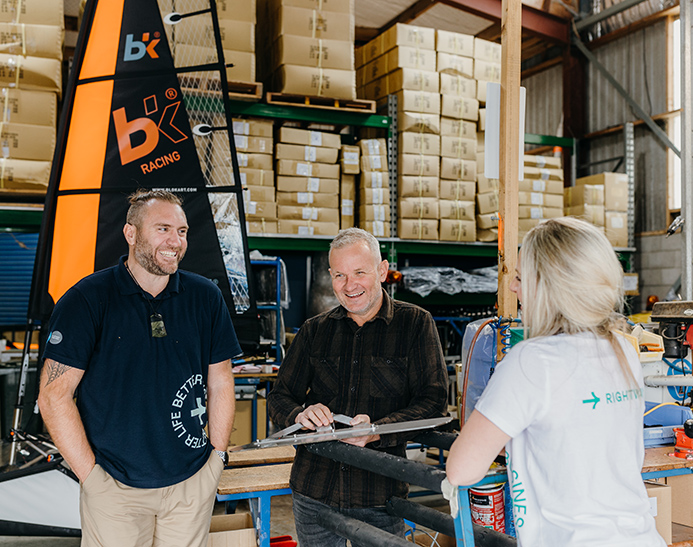Running a small business guide
According to MBIE stats, there are around 530,000 small businesses in New Zealand. Small businesses may range from sole traders to companies with a few dozen employees (definitions on what a small business is can be read about with MBIE’s dedicated guide). Most ‘small businesses’ have 0 employees, followed by 1-5 employees (this makes up around 500,000 of the total).
This guide has been put together with these businesses in mind - although anyone growing a small to medium business should find these insights helpful!
Establishing all your operating costs
Without having visibility of all your recurring monthly costs to keep the business going, you’ll struggle to model out what your profit margin will look like. Operating costs in a small business should be ideally kept as lean as possible without sacrificing the effectiveness of your business. As a small business owner, you are more than within your rights to ensure you are making money at the end of the month. The more that goes to operating costs, the less left over to pay yourself or build up a buffer should this be needed.
So, what do typical operating costs entail? Here’s some to get you started:
- Premises lease
- Power
- Internet
- Phone bill
- Consumables
- Accounting fees
- Subscriptions (e.g. Xero)
- Marketing costs
- Materials (e.g. wood for builders)
- Vehicle insurance and upkeep
- Petrol
- Salaries/Wages
- Lease or payment of equipment
Essentially anything you pay for that’s required for proper running of your business to generate revenue comes into your operating costs. As you can tell, the list can balloon out relatively quickly.
To establish exactly what you need:
- Put together a spreadsheet of everything, starting with must-haves through to nice-to-have. Create a column for the item and one next to it for the monthly cost.
- You’ll want to have a uniform frequency of cost in this sheet, even if some costs are incurred weekly and others monthly. Simply multiply or divide accordingly (monthly is probably easier).
- Take the sum of all costs (in Google Sheets this is: =SUM([select cell range])
- You will have your total operating costs.
- Now you can review your total revenue for the month and start to build a picture of whether the business is making money or not.
Remember this does not take into account one-off costs, PAYE, and Income Tax. These are kept separate.

Do you need extra employees - or better efficiencies?
Hiring a staff member is a big leap for a small business. Suddenly you’re responsible for another person’s income. When a small business reaches certain thresholds of income or growth potential, hiring may be the best move forward. But in other situations hiring can be premature when business inefficiencies are soaking up your precious time as a business owner. Addressing these first will help your business grow the right way, and be better for your bottom line.
Signs your small business may need to hire someone
There are some tell-tale signs that hiring could be the next move:
- You have more demand for your services than you’re able to physically accommodate.
- You don’t have enough time to focus on the growth and direction of the business.
- You’re missing particular skills that would be complementary to your business offering.
- You’re not getting customers who would need multiple people involved.
- You’re spending too much time on lower value parts of the job.
These aren’t the only reasons, but they’re common for many small businesses to encounter. If things are going well in your business and you have growth aspirations, it might be worth considering looking into the market for someone to help!
Making sure the business can sustain employee wages
Hiring a staff member does come with risks. Some small business owners may encounter scenarios where the work their employee delivers doesn't quite stack up to what their own standards are. While training can help bridge this gap, you’re never 100% in control over how another person approaches work. Then there’s the risk of losing that employee in a business that relies upon the extra set of hands to service all your customers.
But the risk that keeps many business owners up at night is the possibility that revenue/customers decrease and the business still needs to afford to pay that employee’s full wage or salary. It’s a reasonable concern to have; a contractual agreement is in place with your employee and they’re protected by certain employment rights.
While there’s no 100% guarantee of protecting your employee’s job in every scenario, there are a few ways to build a safety net. First, consider building the business to a point where you can conceivably hire and pay someone, and get paid yourself without taking on any additional customers or revenue. In short, you can afford to carry the staff member before unlocking the growth potential they enable your business.
Second, and this is not instead of but as well as, focus on building up a ‘war chest’ or ‘rainy day’ cash reserve where the business can sustain all its operating costs including that employee for a period of months. In a business that may have a quiet month here or there, this is especially useful as a backstop to have.
Find ways to streamline the business first
Before hiring, consider whether you’re doing everything in the most efficient way possible. Streamlining a business can be done in a number of ways. Two key areas to focus on are the administration side of the business and the provision of services or products to your customers.
Running the business’ accounts, sales, marketing, premises, and customer relationships isn’t a small job. Find ways to reduce the time spent on each of these - perhaps engaging an external accountant and bookkeeping will earn back precious billable time. Work with a tool like Xero where your sales and expenses are reconciled and coded making reporting and tax compliance much easier. If you’re a comms-heavy business, look for template opportunities. Are there a number of questions potential or existing customers ask? Keep a document of pre-written emails that can be personalised quickly and sent out.
If you’re a business that visits clients on site, spend some time with your scheduling and find ways to consolidate jobs in one particular area each day, removing the travel time. Even if this is charged to the customer, it’s arguable that more time spent at each job offers more revenue opportunities than when you’re in the vehicle.
Efficiencies in your work may be able to be gained through reimagining your services and reducing the lower value and time-consuming services in favour of those that deliver a healthier margin. If you’re a product-based business, your costs of goods may be able to be lowered per unit with bigger orders. Putting processes around your work can also help to fit more customers in for the same amount of time.
Exactly how your business can become more efficient is going to be subjective. But one thing is almost certain; there are inefficiencies in your business that present opportunities today. Chat to our team if you want to talk about how.
Finding premises vs. working from home
Premises are one of the most significant, non-human-related costs a business can incur each month. For some, premises are essential to serving customers properly. For many businesses, they are a preferred way of working, providing a more professional presence and a place for employees to meet and be a team. For others, premises simply aren’t required as business is conducted offsite, or at home online.
There is no one answer here, but there are pros and cons to each route.
Benefits of premises
So, why would you choose to move into dedicated business premises?
- The team has somewhere central to meet.
- You can focus on work solely without distractions on the go or at home.
- The premises can provide a professional space to host potential clients.
- You can provide a showroom for your products.
- There's a clear separation between home and work life.
- You’ve got more space to set up your workspace how you like (not constrained by your home’s layout).
- The office/premises can live your brand through signwriting and interior artwork.
- The physical existence of your business may be more attractive to some customers.
- It may also be more attractive to prospective buyers of your business.
- For some types of businesses, it may help you present as a more legitimate
Benefits of working out of home or on the go
A purely mobile-based business or one that’s run from home has some advantages:
- You remove the cost of a lease from your operating expenses.
- Your utilities can be used at home to run the business.
- You can work for days ‘out in the field’ without having to think about keeping a premise ticking over.
- Some business owners may be much more productive working from home.
- You don’t need to worry about fit-out or interior design.
- You can move your operations anywhere.
- There’s no commute.
- More flexibility around family commitments.

Making sure the numbers work
A business of any size lives and dies by the financials. Without the business generating income, there’s little chance of long-term survival, even with outside investment. But what most business owners fail to realise is that understanding the numbers isn’t something they need to shoulder alone. External business guidance and accounting can help you focus on the parts of your business you feel most capable of.
To get you started, here are some important considerations with regard to your business’ numbers:
Small businesses need to watch every dollar closely
And big ones do too! But a small fledgling business rarely has the luxury of unnecessary expenses or spending. Even $50 spent each week on a cost that could be avoided will make a difference ($2,600 of a difference each year in fact). Watching every dollar closely is made easier when your work account is attached to a tool like Xero, where every dollar in and dollar out needs to be reconciled against something. You’ll be able to run reports on particular costs and find out where your money is going.
Assessing your bottom line - are you making money?
You might be surprised to hear that many businesses with good revenue aren’t making a lot of money at the end of the month or financial year. The bottom line refers to the money the business makes after all expenses are taken from revenue and other income. If a business owner focuses too much on the top line revenue without taking the time to understand how much of it is leftover decisions can be made that don’t actually serve their own personal financial goals.
Growth isn’t automatically or immediately a translation to making more money after expenses. In fact, in periods of growth a business may see its margins decrease somewhat as the cost to run the business grows as well. This is why we encourage clients to look at more components of their businesses beyond sales and customer numbers in order to be more successful.
The bottom line can and ultimately will have to be driven by an increase in sales. But there are potentially big impacts on your bottom line with a careful review and optimisation of your costs. Using an experienced business advisor can fast-track this process, identifying common areas where expenses are too high and addressing these accordingly.
Signs your product or service needs a price change
Do some competitive research and look online - what sort of costs do similar businesses charge their customers? Even if your model is value-based, undercharging is a huge strain on a business's ability to grow. Every dollar that you undercharge (per hour, per service, or per product) mounts up quickly and will put more demand on your operational costs to be as lean as possible. If you’re providing a good service, why put this pressure on yourself?
Other signs your prices may need to be reviewed:
- Potential and existing customers continually comment how ‘cheap’ your prices are - positive for them, not so much for you.
- Other competitors are winning business despite your being as capable if not more - low price may infer less experience (rightly or wrongly).
- You have to cram in more work than would be preferable in a typical workday to make ends meet.
- The value of what you provide customers is more than what you’re being paid - this one’s sometimes subjective, but in many cases, there’s a tangible benefit to them that you can quantify. For example, if you’re working in professional services and your work directly helps your client make 50x what you charged, there’s potential for revisiting costs.
- Your cost of paying employees to do the work leaves you with little at the end.
- The costs of producing your product or offering your service increase.
It’s so common in New Zealand for businesses to undercharge. Don’t be afraid to miss out on work because you’re ‘too expensive’. The most profitable business engagements will be those who aren’t questioning every dollar spent with you but those who recognise and benefit from the value you bring.

Considering personal goals as part of the business goals
A small business owner may feel the need to keep business and personal objectives separate, but here’s the reality; they’re not. Your business should help you achieve your personal goals. Why else would you be in business? If a business owner starts to forget about their own purpose, the business will serve others before it will serve them.
Your personal goals may include:
- Retirement by a certain age.
- The purchase of a dream house.
- Being debt-free by a certain age.
- Leaving a certain amount of money for your children.
- Buying a boat and sailing around the world.
We aren’t the ones to tell you your personal goals - that’s up to you! Regardless of your dreams, your business should be designed to get you closer to these. A successful business enables your life goals!
It’s also important to sit down and establish what these goals are with the same level of rigour as you may a business plan. This is a key part in building your ‘why?’.
Marketing your business
Marketing is central to the growth of your business. But running ads straight away without putting together a strategy is a risky move - you can spend a marketing budget with no benefit to your business. Here are some tips on how you might go about approaching marketing properly.
Creating a marketing budget
The first thing you need to work out is exactly how much you have to spend on marketing. Don’t fall into the trap of picking an arbitrary number and sticking to it; there’s a more scientific way to figure out what to spend.
What you want to do is start with how much each customer is worth to you - both at first sale and then how much repeat business they’ll give you. If you don’t have this data at hand, use some best estimates based on the average cost of your sale and a conservative guess for repeat business. This should give you a lifetime value.
With your lifetime value of a customer, you can then establish how many customers you'll need to acquire to reach your business’ financial goals in terms of revenue.
So up until here, you may have something like the following:
- Average customer sales = $200
- Average repeat business for customers in a year = 5x
- Total customer acquisition annual value = $1,000
- Revenue growth by end of FY = $20,000
- New customers required that year = 20
Now, here you may decide how much you’re willing to spend on acquiring a new customer. If it’s typical for a customer to continue engaging with your business for years, you can justify spending a bit more to secure them in your marketing.
Let’s pretend that you’re willing to spend $250 to secure a new customer, based on the premise that most of your customers stick around for 3+ years. Therefore, you’re spending $250 to make $3,000+.
Here’s how you can build your marketing budget with this information:
- 20 customers x $250 cost per acquisition = $5,000 in marketing spend
Now, this is a reasonably basic example and you may find that early on there’s more work to be done in marketing to establish your brand in the market. But the process should help you go from ‘how long is a piece of string’ to a number with a bit of logic behind it.
You’ll find that your ROI in the first year will be lower for customers, then much higher in subsequent years where they’ve already been acquired.
Doing your research on customers and competitors
Now it’s time to research who your customers are. As a small business owner, understanding your customer’s habits and motivations can greatly streamline your marketing efforts.
Here are some quick tips for understanding your customers:
- Survey your existing customers and ask them what their motivators are for doing business with you.
- Find out what parts of your service they like or don’t like.
- Go online and look for social media groups, forums, and websites where your customers may spend time. What are the conversations or challenges they’re having?
- Set up a Google Ads account and conduct some keyword research to understand what terms people are using to find your services or products in Google Search.
Your competitors are another source of insight:
- Go through your competitors' service offerings on their websites and cross-check this against what you provide. Is there anything they’re doing that you’re not?
- Build a map of how many local businesses are competing with yours.
- If available, find out their pricing and work out where you sit in relation to competitors.
Reviewing your competitors’ offerings is also useful to build a sense of what makes you special in the market. If you’re filling gaps no one else is, this is a marketing tool. Which leads nicely into our next point...
Establishing Unique Selling Propositions (USPs)
Here’s where you want to list out everything that makes your business different from the others. While these might not directly be dropped into advertising, they act as a good basis on which to write your marketing. A unique selling proposition or point defines your business and its services in a way that would effectively communicate why you are a better choice than the competition.
Here are some prompts to get you started on your USPs:
- Customer Service
- Pricing
- Value guarantee (de-risking)
- Sustainability
- Values/Ethics
- Exclusivity of product
Business owners often get into business when they see a gap in the market not being filled. Start here, and list out all the things that make you the preferred choice.

Getting set up for digital marketing
Digital marketing is an excellent avenue for most business owners because it can be effective with even smaller budgets. There are a number of areas you can work on promoting your business digitally.
Website
Your website should present your business, its products, and services clearly. It’s also your central hub where many of the channel-based advertising will point to. On a website, you’ll want to have dedicated pages for each of your offerings. You can also create what’s called a ‘landing page’ where you design an experience for a specific audience. Then with paid advertising targeting options, you can put ads in front of that specific audience for a nice and cohesive ad-to-website experience.
Some tips for website creation for a small business:
- Do your homework on website developers and designers. Look for their portfolio of work to determine if they’re right for you. Enquire about speed, SEO services, and how easy it is to update the website in-house. There's no point in having a pretty website that doesn't work well and is costly to maintain.
- Make sure you get a number of quotes and an approach from a website agency before you commit.
- Be clear on what you need (and as importantly don’t need) from your website.
- Have a budget in place and ensure you get a flat fee for the website development.
- Ensure the scope is very clear.
- Make sure you write a good amount of information for each page - thin content on websites, especially new ones will struggle to rank in Google.
- Ensure your website is optimised for mobile use.
- Make sure you have a brand design that is carried over onto the website. Some agencies will take care of building your brand, logo, colours etc, and your website.
Alternatively, you can set up your own website to start, for free (apart from your time) and a small fee for hosting. A great option for this type of website is Squarespace.
Social Media
Social media includes LinkedIn, Facebook, Twitter, Instagram, and YouTube. Different types of businesses tend to do better on certain platforms. For example, professional services and corporate-based businesses are at home on LinkedIn. Facebook might be better for more community-based businesses or trades. Instagram is essential for any business selling products thanks to its visual-centric feed.
If you’ve got the time, running a number of social media channels can help to keep your business active and front of mind.
The key to building up your social media presence is first by connecting/inviting followers and publishing content fairly regularly. If you’re light on time and don’t have any help to do this, pick one channel and focus on posting content on that platform alone. With Facebook, you can even schedule a published post so there’s content going out across the week evenly, even if you line everything up one evening a month! Additionally there are a lot of scheduling tools that allow you to post to more than one social channel at once and schedule post to varying platforms. A great example of this type of software is Planable
Unsure of what to post?
- People/introducing the team
- New products and services
- Examples of your work (e.g. photo of a completed house).
- Seasonal/time-sensitive posts
- Discounts and deals
- Funny posts (just make sure it’s appropriate for any audience!)
- Blog posts you may write on your website.
- Industry insights.
Not every post needs to contain a bunch of information. The key here is helping the general public understand who your business is and what it stands for.
Search Engine Marketing (SEM)
Google is an excellent channel for acquisition, both through organic and paid results. People who search for your services are in the market and often ready to act, so you shouldn’t ignore this part of your marketing mix.
When looking to rank better in the organic (unpaid) results in Google there are a few key areas you’ll want to pay attention to such as how quickly your site loads. But one of the best ways to create a website that ranks well is to focus on making a good experience for your visitors.
This means that content is really important. Your website needs to provide good information to rank in Google, especially if you’re a new website. Many businesses fail to spend enough time explaining to visitors (and thus Google) what your business is and what it provides. One way to ensure you’ve got a good amount of information on your website is by running a blog. Google ultimately wants to reward and rank websites that best meet the searcher’s needs. Good information is one of the best ways to do this. Just remember, write for your customers, not search engines - and you should see long-term results.
You can also pay to show up in search results for certain phrases. You do this via a platform called Google Ads. Here you can set up targeting, budget, and write short text ads that explain what your business is and its benefits. Google Ads is a popular choice for local businesses, given you can target searchers in your immediate region only. There are a number of components required to make paid ads successful, and we suggest you start with Google’s own resource here. Otherwise, you can engage the help of a digital marketing expert or agency who will guide you.
Getting your business details on Google Maps (Google My Business)
Google My Business is the listing for your business that will populate regional-based search results (often shown under a map). Ensure that you have verified your location through Google’s postcard process and completed every field of the Google My Business profile. Also make sure your name, address, and phone number are formatted exactly how they are on your website, and ensure that you have a link to your website coming from your GMB profile.
Your time is golden; prioritising focus is key
It’s unreasonable to expect a small business owner to manage all the parts of their business without help in at least a few areas. Not only this, it’s probably not the best route to growing sustainability and helping your bottom line.
Choosing what parts of running your business you actually enjoy is really important. If you’re focusing on what you’re good at and engaged with, you’ll have a much easier road towards growth tapping into external help or employees where needed.
Using expertise where you don’t have it will actually save you money in most cases
This becomes a simple calculation - could you earn more money by offloading a component of your business operations to someone else, taking into account their costs? In most cases, the answer is yes. At the very start of your journey, it may be that you do have to do more yourself, but any business plan should include the delegation of certain activities as soon as is practically and financially possible.
Accounting and Tax help
One of the more complex and time-consuming parts of a small business is its account and tax matters. This is not an area to dabble in if you’re not confident in what you are doing. Yes, business owners do manage to complete their own taxes and manage their books, but the question for them is why?
We think that lots of NZ business owners deserve to be living their dream and doing the things in their business they’re truly interested in. Moving your accounting and tax to an accounting firm/tax agent also helps you ensure that all deadlines are met. There is usually an extended date for filing when via a tax agent as well.
Tools down - protecting some of your time for business development
Valuing your time is also crucial when strategising how you’ll get to the next level. Businesses may grow organically over time, but there should be some deliberate direction around how the business should develop. Without working on the business, your goals may take far longer than they need. Business development might look like this:
- Researching the market more to refine your products or services.
- Assessing which products or services make the most money.
- Building new relationships with others in the industry that could translate to new work.
- Hiring employees and training them up properly.
- Attending training courses or conferences.
It can be really tempting to skip over this stuff when you’re a small business. Use your judgment as to what’s actually possible. But each month there should be at least a few hours where you’re thinking about your business and its journey vs. the next customer. One way to take some of the effort out of this is by engaging a business advisor who can apply learnings from other businesses to fast-track your own development.

Quality control and evolving the business
Quality in your work is hugely important. It both protects your reputation in the market and keeps existing customers loyal. Retention of customers is a greatly underrated part of most businesses’ strategies - big and small. Small businesses will often start out with very strong relationships with a relatively modest customer list. The challenge becomes when growth is at a level where there are too many customers to give the same amount of attention, but not enough that warrants a full-time relationship manager. This is when a business owner may see fit to engage employees for more work allowing them to ensure the customers are happy.
Measuring customer satisfaction
There are a number of ways to work out how engaged your customers are.
Surveys are probably the most valuable to a small business as they give you both quantitative feedback and qualitative feedback that you can action changes off the back of.
A Net Promoter Score is another popular mechanism to understand how your customers feel about your business and their likelihood of becoming advocates or ‘promoters’ of your business. There are tools that offer customer surveys and NPS functionality. Having this intel available to you and taken periodically can show trends in the right (or wrong) direction so you can measure the impact of your relationship building efforts.
Small business owners can also take the old fashioned route - meet with or call their customers and ask for any feedback or suggestions on what they could do differently.
Identifying areas of improvement in your product or service
These conversations and surveys are excellent for applying product or service innovation and improvement. It’s unlikely that you’re doing everything perfectly all the time, so distilling what you’ve learned from feedback and combining it with research into your market is a great business move.
Staying close to what’s happening in your industry
Even the most enduring of industries have evolutions to deal with; a new building code, technological disruption, or new customer types. Keeping informed as to the latest in your industry ensures you stay ahead of any risks to your business, make use of new resources and demonstrate to your customers that you’re the best choice to deal with.
Getting the basics nailed
Quality service and your customers’ perception of this so often comes down to a really simple question: did you deliver what they wanted or not?
Your services whether it’s building, IT, or hairdressing need to be sharp so your customers feel like they had a good experience. As a small business owner, you know what the ‘basics’ are. Practicing these daily, it might be taken for granted that of course, you have this nailed. But over time, have you kept these skills intact - and does every member of your team possess all the core skills to ensure every customer gets a good experience?
In a period of fast growth, it's the basics that will see you survive the various challenges any business faces.
Not sure what your next step is in your small business?
RightWay works with many small businesses every day on all parts of their business. We empower business owners to make good decisions. If you’re stuck or know you need some help with running your business, chat to us about our options for a dedicated business adviser.
Read our other business growth guides
Many highly ambitious business owners and entrepreneurs have dreams of taking their businesses to the big time. But scaling a business is so much more than adding headcount or indeed customers. In reality, scaling needs to be part of a careful business strategy in order to retain the magic of the small business and unlock the benefits of a large business.
Cash flow is what drives your business and keeps you awake (or preferably, asleep!) at night. Put simply, cash flow is the lifeblood of your business. It’s also one of the most important measures of success of your business. Your business is like the game of monopoly – you can’t pass “go” without cash flow.
Managing a business can be overwhelming! More often than not you’ll be wearing multiple hats throughout each day as you flit between being a people manager, managing the businesses financials, forecasting, strategically advertising your products and/or services, researching new technologies along with a multitude of other tasks required daily!
With more than half a million small business owners in New Zealand, there’s a breadth of backgrounds, cultures and approaches that make up our community. But while small businesses really do take all sorts, we’ve been able to observe the common traits that all successful owners appear to have. In this article, we’ll cover what some of these are. The good news? All of these traits can be worked on and developed with a bit of focus and the right support.
Okay, it may sound like a silly question. Of course you know your business! Who’s closer to your day to day operations than you? And that’s fair enough. But when small business owners are doing everything, there’s going to be elements of the business that get more attention than others. It’s only reasonable that providing your service to your customers is priority number one. Even well-established small businesses turning over reasonable revenue can lose sight of the detail around the financials.
Ever competed in a race where you weren’t told where the finish line was? Tried your hand at baking without a recipe book? How about leaving for holiday without packing your bags? If these all sound ridiculous to you, then let us draw the comparison with a business that doesn’t make plans. Making plans and understanding parameters is so important for business success, but many fledgling businesses have barely planned tomorrow let alone the long term.
It is very normal for business owners to be entrenched in the daily goings on of their businesses. With varying to do lists and high priority tasks requiring their daily attention, it can be hard to take the time to stop and look at the big picture. And that’s just the business part, let alone our busy, and somewhat chaotic, personal lives.
However, it is vital as a business owner or business manager to periodically pull your head out of the trenches and take the time to sit back and review your business as a whole, to ensure you are on track to success.



